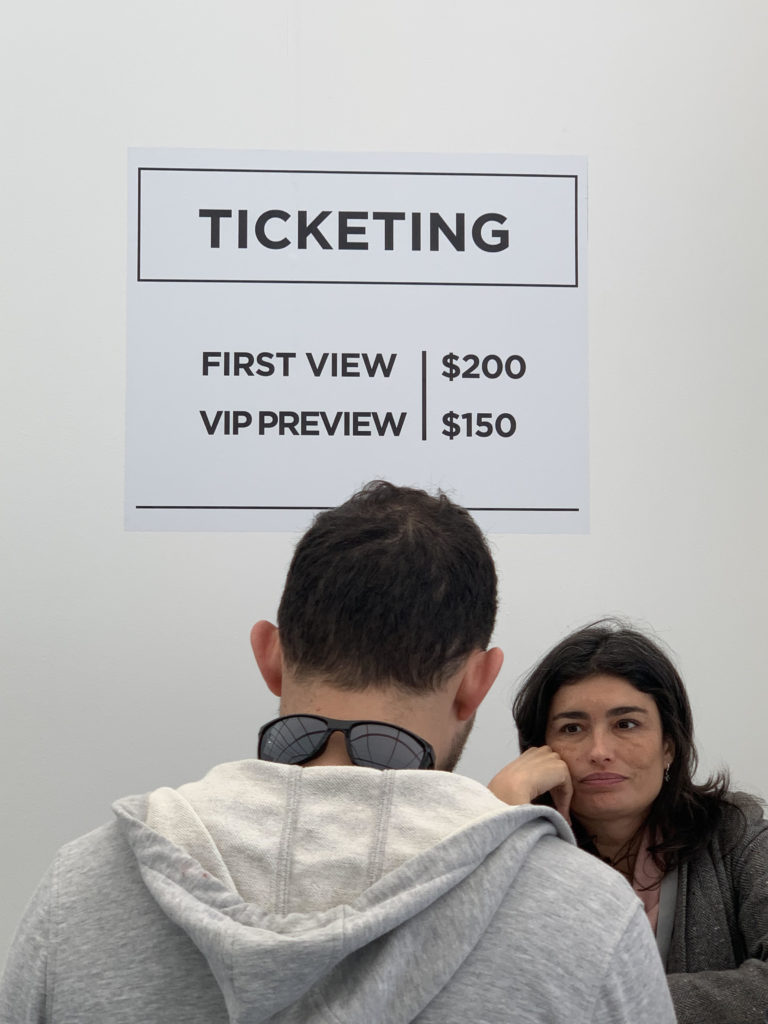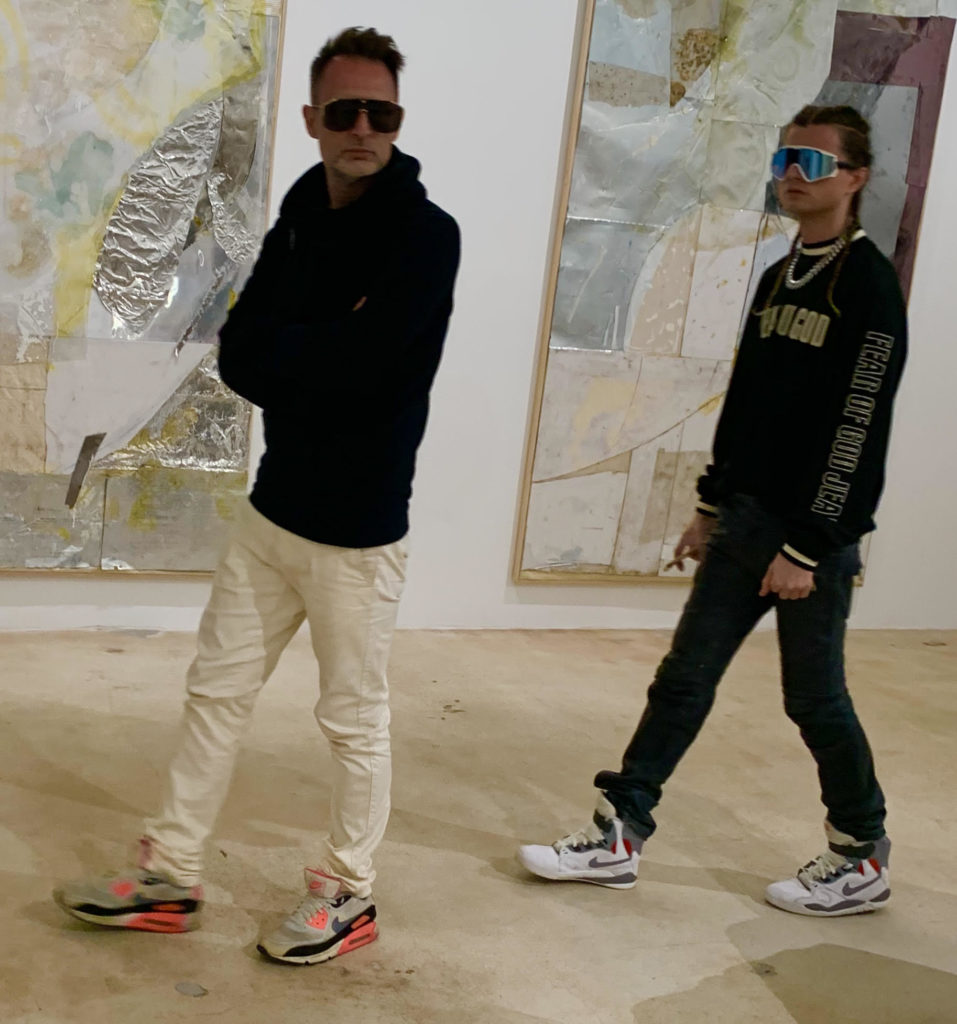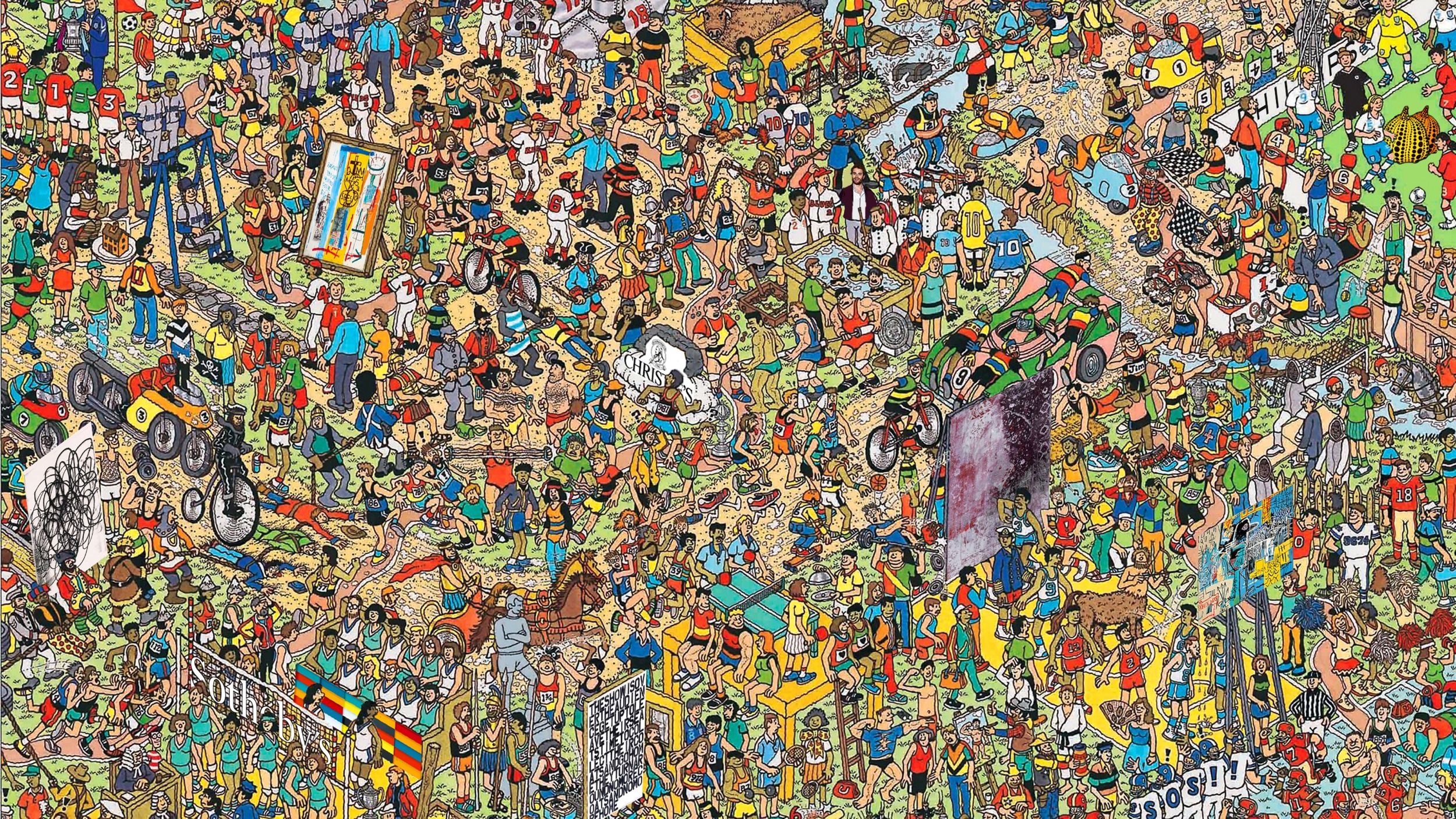“Where’s Inigo,” a new puzzle for the whole family. Artwork courtesy of Kenny Schachter.
The only thing more scrutinized than the whereabouts of the Salvator Mundi—which I happened to locate on a certain boat in the Middle East—is the art world’s new game of “Where’s Waldo”… I mean Inigo, as in the vanished accused art swindler Inigo Philbrick. And guess what? I found him too! Before the reveal, let me share the most fantastical of events that unfolded in a breathless 24-hour span the day after I left Art Basel Miami Beach.
Seething at losing so much money due to my “friend” Philbrick’s well-publicized dastardly art dealings (to put it mildly), I Instagrammed a faux reward poster for information leading to his arrest. I received two direct messages from one steve_irwin_pets, the first being: “I hope he’s ok and safe and sound!” This was followed by “Innocent til proven guilty!” to which I, um, might have replied, “Are you fucking joking?” (You try losing a small fortune and see how it tastes.) I then let go of the convo—only to pick up the thread a few hours later.

One victim just volunteered to kick in another $10,000, and I lost enough already to raise the offer myself, so call it $20,000 and rising…. Wanted poster courtesy of Kenny Schachter.
I began to push “steve” and push, and push harder still. At first, his responses spoke of Inigo in the third person (and thankfully I saved more than 80 screen shots of text before the account vanished liked its holder):
“Nothing is irreparable. Hopefully everybody will see the fact he was a young man in an immense position of responsibility out of nowhere who wanted to make everybody happy and over promised and under delivered in the end but to no personal benefit….”
“If he’s smart enough to do it in first place he’s smart enough to make good on it.”
“It will get sorted and this is not meant to cause hurt. It’s not one man’s fault and you know it [I do?]. Right now it’s about rebuilding rather than any further pain.”
Three-hours-without-pause later, as it became obvious, he let his guard down:
“It’s no big deal, I did nothing wrong and It will all be forgotten soon.”
“Much better idea is to mediate and find a way forward.”
“Nobody was stiffed, it was just a few bad deals. Things will be made good.”
Stay tuned… there’s a hell of a lot more (gnarly) background detail I know here, but I’m saving that for the screenplay I am shopping. And when The Wolf of Wall Street meets American Psycho, what a movie that will be. Admittedly, most art movies are so awful and off the mark that the competition isn’t exactly daunting, but this could be the film to change that.
Once my blood pressure levels returned to earth, and I drifted to sleep, I was awoken at 3 a.m. by a call from Adrian, my 23-year-old son, as he’s wont to do. When my screaming relented, he said, “I know where Inigo is.” What kind of dream is this I thought? “I just spoke to a friend who had lunch with a kid who was bragging that he met some crazy guy who stole a fortune from the art world.” “Where is he?” I muttered in my phlegmy, half-awake stupor.

Steve was fatally stabbed by his favorite fish, and Inigo believes the art world is out to get him too. Screengrab courtesy of Kenny Schachter.
Speculation as to Inigo’s location has varied wildly, almost on a daily basis: Thailand, South Africa, South America, the Bahamas, Cuba, among other locales. But the truth was in fact Sydney, Australia, where he had been visited by his girlfriend Victoria Baker-Harber en route to a micro-island in the Pacific, and I have a hunch which one—a hunch that was confirmed by a local bar/club owner. In any case, Australia explained the Steve Irwin moniker, the Aussie naturalist speared to death hundreds of times by one of the stingrays he cared about so deeply. Get it? Call it a holiday getaway-getaway. And, by the way, in this story, Inigo is the stingray.
Let me say this for the man, who indeed is innocent in the eyes of the law until proven guilty—although the cards are certainly stacked against him—the art world is built on lies and sleazy behavior. I’ve yet to meet a single participant in the market with totally clean hands—except, okay, Marian Goodman. There were auction houses that lied about being paid on time in a factually incorrect Philbrick expose in ARTnews that kind of threw me under the bus for the closeness of my former relationship with him—a weird strategy for a company trying to woo me to switch allegiances from Artnet News—and dealers that denied the closeness of their relationship with him. Yes I’ve been Inigo’d to the tune of well over $1,000,000, which isn’t the best feeling ever, but he also did loads of business with Hauser & Wirth, Lévy Gorvy, Gagosian, and Zwirner—whether they knew it or not (he often employed proxies to do his bidding)—and Jay Jopling, his former mentor.

I’ve been Inigo’d and it wasn’t fun—or cheap, but the t-shirt is. (No Cattelan relation.) Artwork by Kenny Schachter.
What is inexcusable, big-time, is Philbrick’s debt to a real shark—not a hard-edged, pissed-off money mogul, but, worse: a hard-working art photographer named (for real) Shark Senesac, who shot Dana Schutz’s Unicorn just before Philbrick’s downfall went (very) public and got stiffed as a result. You can’t make this shit up. The Art Loss Register needs to open an Inigo Philbrick division. Another annoyance is Jeremy Hodkin, the 28-year-old publisher of a newsletter ingeniously entitled the Canvas, who neither knew Philbrick nor participated much in the art world (yet the market). He wrote the following poem:
‘His business was hollow, built on a bed of lies,
With a bit of a reputation as a prick.
As dull as a hammer, he’s our least-favorite scammer,
Of course it’s the reviled Inigo Philbrick.
OK. Here’s my version:
His business started great, but that wasn’t his fate.
Sure he was arrogant—but funny and smart.
He bit off more than he could chew. I hope this won’t happen to you:
To get fucked by a friend and lose all your art.
Art Basel Miami Beach

Scope admission. As John McEnroe used to say, “Are you fucking joking?” Photo by Kenny Schachter.
Now, off the races! By which I mean Miami’s art fairs, 2019 edition. I’m no elitist—far from it—but I was early for a meeting and dipped into the “emerging” Scope Art Fair, which gave me a rash before I made a hasty retreat. A daily ticket was $200 for the preview and up to $150 per day, versus $65 for Basel. Pff. Further along the beach was a mechanized vehicle emptying garbage cans—which I thought would make a good vetting machine to clean up the crap art that litters most fairs. UNTITLED is the new NADA. At the former, the quality seems to improve from fair to fair; at the latter, the energy seems to be fading, with less discoveries at hand.
I bought three works at UNTITLED for a grand total of $12,375—reflecting my diminished financial standing after Ini-go up and left (with all my money). One work was a black-and-white canvas from Steve Turner of Los Angeles by one Brittany Tucker. The artist was—gasp—born in 1996. (Christ, so is Adrian, one of my kids—how did I get so old?) Another was a work by Spanish painter Bel Fullana, born 1985, from New York’s Freight + Volume. I’m a sucker for good-bad paintings, and that one may be the worst! (It’s called Booty Twerking.) And lastly, Homework in the Cafeteria Wrestlers, a painting by Jenna Gribbon (b. 1978) from New York stalwart Fredericks & Freiser, which has been bucking the mid-tier gallery malaise since 1996 and doing it as well as ever.

Brittany Tucker clowning around about some not-too-funny issues. She’s all of 23 and, in my estimation, just great. Photo by Kenny Schachter.
It wouldn’t be a Basel without art attorney Aaron Richard Golub verbally acting out in my direction, screaming at the top of his robust 76-year-old lungs—yet again—in a widely witnessed display of personal animus. For some odd reason, it always seems to happen in Simon Lee’s booth. (There should be onsite anger management attendants, with nifty Art Basel-branded arm bands perhaps.) The fair itself was status quo, a little quieter than in the recent past, with the usual suspects succeeding as ever—and the rest not.
Success has proven more elusive for MCH Group, the parent company of the fair, which in dire financial straits due a downturn in the watch industry and other components of its business. (To such an extent, in fact, that MCH was even the subject of a Page Six entry speculating on the eminent sale of the Art Basel fair division.) I can’t deny I’d be slightly amused if the omnipotent Basels went belly-up and there was a jolt of anarchy injected into the staid fair hierarchy.

Going, going…. Could it be bye, bye Basel in its present ownership form? Screengrab courtesy of Kenny Schachter.
With Hong Kong demonstrations as large as ever, a letter was circulating among dealers—with around 20 gallery signatories to date—trying to get Art Basel HK cancelled. But the dealers chickened out, fearful of the repercussions: skip one Basel, don’t bother applying for the rest, is the unspoken threat of the strong arm of fair management. My gallery friends (and I have more than you think, thank you very much) also told me of a pronounced Midwestern vibe in Miami, with collectors escaping the bitter winter of flyover country and helping generate better business than the galleries saw for the last two years. Another fair exhibitor spoke of the rise of “third-rate collectors and an over-the-top influx of (even more than before) art advisors”—yuck. Overall, I’d say there was a chilled atmosphere—not just because of the beachfront locale’s colder-than-usual temperature—with lower price points and smaller crowds.
After I told my dear frenemy (aren’t they all?) Gavin Brown one night that I was working with his artist Bjarne Melgaard for the Felix Art Fair in LA during the upcoming Frieze Week, he responded that me and Bjarne deserve each other, before madly kissing my face, biting my cheek, and departing in a flash with a mouthful of my flesh. I picked an opportune time to quit drinking this year, and was likely the only sober person in Miami.
A friend tried to buy Gagosian’s Jeff Koons metallic dolphin before the fair for pretty much the full ask—$4.5 million, after a 10 percent discount applied to $5 million ticket price—but when a dealer asked the artist’s rep, she refused to play ball (I’d gather because she was gunning for a commission of her own when it sold at the fair). It didn’t, last I checked. I’m sure Larry G. will be thrilled when he reads this.

Give this Picasso a break— it’s been to so many fairs it’s exhausted, in more ways than one. Photo by Kenny Schachter.
The art game would give any competitive contact sport a run for its money. Landau Fine Art has had an oversized eyesore of a green Picasso on show at no less than 15 to 20 fairs for a price that has escalated from around $15 million (when I first asked) to the present-day $36 million price tag. I guess the sum goes up in proportion to the painting’s accumulation of frequent-flier miles: an art-fair orphan.
Special mention goes out to the elegant, inimitable—if grumpy—connoisseur of connoisseurs, Karsten Greve. There will never be another of his caliber (and demeanor), and that is far from a good thing. I once spied him hiding behind an upside-down copy of the Financial Times at a FIAC so he wouldn’t have to engage with fair riffraff. I aspire to such larger-than-life levels of reticence. He bought his first Twombly in college (he may very well be the world’s most knowledgeable expert on the artist) and proudly showed his father, who wrote him off then and there as a hopeless cause and black sheep in their family of physicians.

K&K. The last time Karsten Greve kracked a smile was probably at his first Basel 50 years ago, and I am in love with him because of it—and his amazing tenure as ace gallerist/connoiseur/collector. Photo by Gagosian Chief Operating Officer Andrew Fabricant (!).;
The Rubells, meanwhile, are prescient and outright brilliant professional collectors, and their new museum occupies a peerless position in the realm of post-Saatchi privateers, period. If there’s one criticism I’d level (I gotta be me), it would be that some of the loosely themed groupings of artworks, like artists of color, artists of China, or artists of the ’80s. Why not chuck it all into a mix less obviously delineated? Also, while they’re at it, can they please use their Miami clout to pass a law mandating imprisonment for people who look at art wearing sunglasses? They should be outside—of the museum.

Award for worst sunglasses infraction at Rubell Museum, nothing like going to a museum to not-see art! Ugh. Photo by Kenny Schachter.
Finally, my condolences to the legendary and fervent collector, investor, and philanthropist Don Marron who, a matter of days before he died, looked me straight in the eyes at Miami Basel and said, simply, “Kenny, you must keep writing.” Don was an art lifer to the last day, literally, and an inspiration to us all. I will never stop, Don, and hope to drop at my keyboard—or better yet, in the aisles of an art fair or auction, disrupting the proceedings to the bitter end.

